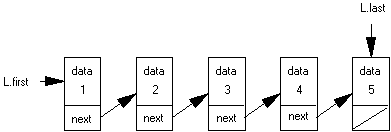
Lesson32 lab exercise - list1
Background:
1. The student outline contains a program which stored a linked list of five nodes, but in reverse order. The objective of this lab exercise is to create a linked list with the nodes assembled in order as they are generated. If a loop is used to create the values 1-5, the resulting list should look like this:

The next
value to be inserted would go at the right end of the
list. To
avoid traversing the entire list each time, two
pointers will provide access at the front (L.first =
left end) and the end (L.last = right end) of the list.
The first and last pointers will be packaged as
a structure.
struct
listNode
{
int
data;
listNode *next;
listNode (int, listNode *);
// struct constructor
};
listNode::listNode
(int tempData, listNode * tempNext)
{
data = tempData;
next = tempNext;
}
typedef
listNode* listPtr;
struct
listType
{
listPtr
first;
listPtr
last;
};
In
function main
the declaration of the data structure would be
something like
listType
L;
2.
You are encouraged to use a struct
constructor in this lab.
3.
Your lab work can begin with the example program
from Handout HA31-1, listDemo.cpp.
4.
If you do not use a struct constructor, the for
loop inside of function createList
should still be set up in ascending order, i.e.,
for (int k=1; k<=20; k++)
insert (someList, k);
void insert (listType &temp, int value)
// Takes in value, packages it in a new node, inserts the new node at the end of the list.
{
if an empty list then
set both first and last pointers to the newly constructed node
else
construct a new node at the end of the list
5.
If you use a struct constructor, you can skip the use of
a separate insert
function and build the list in function createList.
6. Adjust the code in the other routines as needed.
Assignment:
Instructions:
1. Turn in your source code and a printed run output.